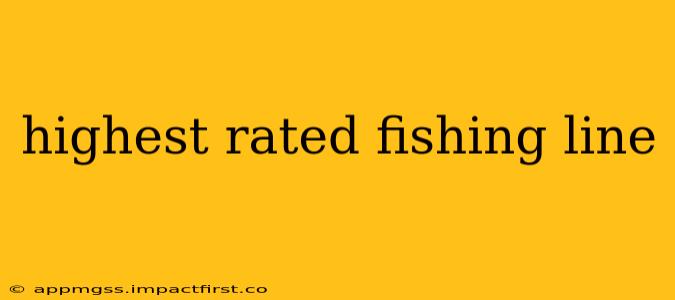Choosing the right fishing line can significantly impact your success on the water. With so many brands and types available, finding the highest-rated option can feel overwhelming. This guide dives deep into the world of fishing lines, helping you select the perfect one for your needs and skill level. We'll explore various line types, factors influencing ratings, and answer frequently asked questions to ensure you make an informed decision.
What Makes a Fishing Line Highly Rated?
Several key factors contribute to a fishing line's high rating. These include:
- Strength: The line's ability to withstand pressure without breaking is paramount. Higher tensile strength translates to landing larger fish with confidence.
- Sensitivity: A sensitive line allows you to feel subtle bites, crucial for detecting strikes from shy fish.
- Abrasion Resistance: The line's ability to resist wear and tear from rocks, weeds, and the fish's teeth directly impacts its longevity.
- Castability: A smooth, easy-to-cast line allows for longer casts and greater accuracy.
- Knot Strength: The line's ability to hold strong knots is essential for secure hookups and preventing breakages.
- Visibility/Invisibility: Depending on fishing conditions and target species, line visibility (or lack thereof) can be crucial for success.
Different Types of Fishing Line and Their Strengths
Several types of fishing line cater to different fishing styles and target species:
-
Monofilament: This classic line is known for its affordability, flexibility, and relative stretch. The stretch helps cushion the shock of a fish's run, preventing breakages. However, it can be less sensitive than other types.
-
Fluorocarbon: Fluorocarbon boasts superior abrasion resistance and low visibility underwater, making it a favorite among anglers targeting wary fish. It's denser than water, allowing for a more natural presentation of your bait. It's also less stretchy than monofilament.
-
Braided Line (Superline): Braided lines offer incredible strength-to-diameter ratios, allowing for thinner lines with significantly higher breaking strength. This translates to longer casts, increased sensitivity, and less line resistance. However, it lacks stretch, meaning it requires more careful handling to avoid breakages.
Top-Rated Fishing Line Brands (Without Specific Product Endorsement)
While specific product recommendations are beyond the scope of this unbiased guide, several brands consistently receive high praise from anglers for their quality and performance across different line types. Researching these brands will lead you to many highly-rated options:
- Berkley: Known for innovation and a wide range of lines to suit various needs.
- Sufix: Renowned for its high-performance fluorocarbon lines.
- PowerPro: A leader in braided lines, offering exceptional strength and durability.
- P-Line: Offers a diverse selection of lines at various price points.
- Stren: A long-standing brand providing dependable monofilament options.
H2: What is the best fishing line for beginners?
For beginners, monofilament lines are a great starting point due to their affordability, ease of use, and forgiving nature. Their inherent stretch helps absorb shock and prevents sudden line breakage, making them ideal for learning the basics of casting and fighting fish.
H2: What is the strongest fishing line?
Braided lines generally offer the highest strength-to-diameter ratio. However, "strongest" is relative to the line's diameter. A thicker monofilament line will be stronger than a thin braided line, but the braided line will be stronger for its diameter.
H2: Which fishing line is best for saltwater fishing?
Fluorocarbon and braided lines are popular choices for saltwater fishing due to their superior abrasion resistance and strength. Saltwater is highly corrosive, so lines with high durability are essential.
H2: How do I choose the right line test for my fishing situation?
Line test refers to the line's breaking strength. Selecting the appropriate test depends on the size and strength of the fish you're targeting, the type of fishing (e.g., freshwater vs. saltwater), and the type of tackle you're using. Generally, erring on the side of slightly heavier line is preferable to risking a breakage.
Conclusion: Finding Your Perfect Match
Ultimately, the "highest-rated" fishing line is subjective and depends on your individual fishing style, target species, and fishing environment. By understanding the different line types and their characteristics, you can make an informed decision to find the perfect line that boosts your angling success. Remember to always consider factors like line strength, sensitivity, abrasion resistance, and castability when making your choice. Happy fishing!
